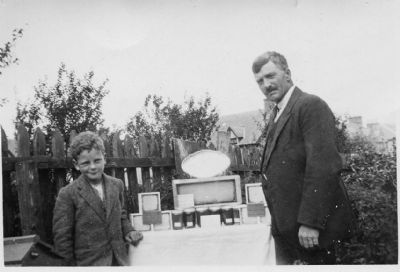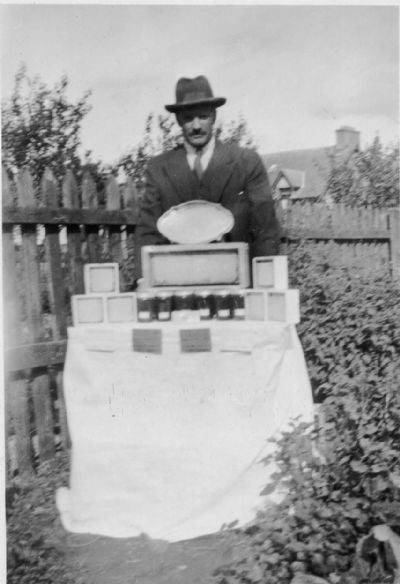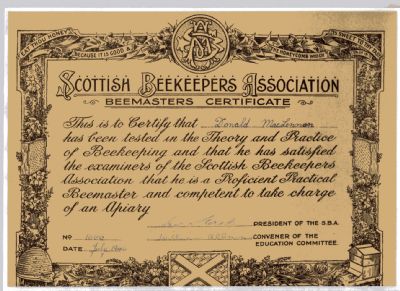History of the Association
In 2006 the Group produced a commemorative booklet to celebrate what was at the time felt to be the 60th Anniversary of the formation of the Group. As the booklet is no longer available it can be accessed from here.
We had assumed that the Association started after the Second World War but this extract from the Ross-shire Journal "88 years ago" (date unknown but could be 2013 if I have done the maths properly) showed that we were mistaken. "Friday, 8th June, 1925 - At a meeting in Dingwall it was decided to form a a local Beekeepers' Association. A membership of between 40 and 50 was expected. Officials appointed were: Hon. president, Mrs Davidson of Tulloch; Hon. vice-president, Dr. Pender Smith; president, Mr D. Macdonald, Millcraig Road; vice-president, Mr. W. Sinclair, Athole Court; secretary and treasurer, Mr. Alex Fraser, Wyvis Terrace.
The following paragraphs have been extracted from the booklet to give a flavour of the background to the Association plus some snippets of information once it was realised that the Association was formed in 1926 and only went into abeyance over the second World War.
Photographs of the 60th anniversary celebration held in Tulloch Castle on the 16th April 2006 can be viewed here.
Photographs of the AGM and celebration of the 50th Anniversary held in the General Purpose room of the Tarradale Primary School on the 24th April 1996 can be viewed here.
Introduction
What else was happening in Ross-shire in the beekeeping world in January/February 1946? (extracts from the Ross-Shire Journal)
1.2.1946 Page 1 Miss Logan to give a Lecture in Cromarty to CROMARTY BRANCH of INVERNESS-SHIRE BEEKEEPERS’ ASSOCIATION.
1.2.1946 Page 5 Local Notes. DINGWALL AND DISTRICT BEEKEEPERS’ ASSOCIATION. Inaugural resolutions as shown on page 4, word for word.
22.2.1946 Page 1 KILTEARN BEEKEEPERS’ ASSOCIATION Address by Mr. Clark of Muir of Ord on the Snelgrove method of swarm control.
All these references were found in an attempt to discover if there had been a Dingwall Beekeepers’ Group prior to 1946, instigated by a reference in the minutes of a committee meeting held on 4th February 1947 where it stated “since the revival of the Association . . . “. It has been suggested that many Groups started around 1920 when Isle of Wight or Acarine disease was at its height and beekeepers were looking for help and advice to control it. Some of these Groups would have carried on through the war and others, such as our own, may have existed and then were put on hold during wartime.
Subsequently it has been discovered that there was a Group active in 1926 in Dingwall. See below for details.
Seasons
1948 The season 1948 can be written down as one of the worst on record, and activities were very much restricted owing to adverse weather.
1949 Owing to a poor season in 1948 there were heavy losses in the Spring of 1949. Spring was not favourable and stocks had to be fed. In the first week of June a heat wave commenced. From then until the end of the season every day was a beekeepers’ joy.
All beekeepers enjoyed a very successful season, honey production was one of the best, both as regards clover and heather. A number of colonies yielded over 100lbs each. With the de-control of price, the average price obtained was 3/- - 3/6d for clover and 4/- - 4/6d for heather. At the commencement of the season there was a ready demand for honey but as the season advanced difficulty was experienced in finding a market and beekeepers were left with large quantities on their hands.
1951 The season can be classed as a complete failure, with little or no surplus. (Second in succession)
1952 Third bad year in succession. “What was most disappointing was the fact that several stocks had to be fed to ensure that they would come through the winter safely.”
1956 A very poor season again.
28.3.1957 The Secretary Mr. Finlayson had the misfortune of losing all his stocks during the previous winter and in view of his work for the Association was offered bees to get him started again.
1958 Clover poor - heather better.
1959 The honey season was excellent - one of the best.
1960 Disastrous - one of the worst on record for clover and heather.
1962 Disastrous again.
1964 Beekeepers procured an average yield with every established colony giving surplus. The best yield verified by Miss Logan was 120lbs.
1965 Average of 20lbs. Good conditions made use of Lime tree flowers. Ling yield was small. Season was regarded as ‘swarmy’ with a high incidence between mid-June and mid-July.
1966 North of Scotland College of Agriculture - Highland Area General Report.
1967 North of Scotland College of Agriculture - Highland Area General Report.
1986 No Honey Show due to second fairly unproductive summer.
1988 Most beekeepers now find their honey laced with oil seed rape which makes extraction difficult and sections virtually impossible.
22.4.92 Talk of new spring sown oil seed rape developed in Scotland - oil seed rape all Summer!!
1993 Plenty of oil seed rape honey.
2000 Poor year for honey production. Some oil seed rape crops had to be destroyed because of contamination with GM seed.
2001 Poor year with cold and wet Spring.
2003 Good beekeeping season with good honey harvests.
2004 Honey season was variable due to localised conditions; some had honey whilst others had none.
2005 So-so.
Bee diseases
24.1.1951 A member of the Association reported the loss of stock as the result of Foul Brood.
May 1960 Miss Logan found American Foul Brood in two apiaries at Lochussie.
1962 Three cases of American Foul Brood (AFB) successfully treated by Miss Logan.
1963 Eight cases of AFB located and treated in the Strathpeffer and Contin areas.
1964 AFB in Ross-shire - 11 cases.
1965 AFB - 8 cases in Dingwall area and several cases of Acarine. Up until this time Sac Brood had been negligible but in 1965 there were a great number of cases.
1979 There were several cases of AFB in the area.
1980 Mr. Mobus showed an excellent film on ‘Varroa’. (Probably the first mention)
22.4.1982 Varroa in Devon, Hampshire and Kent; possibly been here for 2 years.
Autumn 1984 Department of Agriculture did random tests for varroa - still clear.
September 1995 Bob Simpson announced whilst visiting this area that varroa had been found in Perthshire.
1998 Varroa in the Borders.
2000 Varroa confirmed in Carrbridge.
2001 Varroa established in Fife and Tayside and a foothold in Aberdeenshire.
August 2003 Varroa in our own area.
Margaret Logan - “Beekeeping expert”
Throughout her years with the North of Scotland College of Agriculture, Miss Logan did admirable work in developing a valuable rural industry in all the Highland Counties. Her missionary zeal and enterprise in fostering practical interest in bees and honey bore ever increasing fruit. Wherever hives were to be seen, from Inverness to the far North, it was a surety that Miss Logan knew about them and that her advice had been asked, season after season, with beneficial results.
Hailing from Ardross, Margaret Logan was educated at Tain Royal Academy, and with a pronounced agricultural background, naturally gravitated to Craibstone School, Aberdeen, where under the guidance of Dr. John Anderson, she took the expert bee-masters’ certificate. Her results in beecraft were so remarkable that Dr. Anderson determined to have her on the College staff and in 1938 she became assistant lecturer with headquarters in Craibstone.
Whenever possible, she recommended the formation of associations which could do much to keep interest alive, nor was she forgetful of the development of beekeeping and honey production in the widely-scattered crofting areas of the Western Highlands. The ideal demonstrator, she examined from six hundred to seven hundred colonies of bees every year.
In her retirement she continued to give of her vast experience to several groups of her beekeeping friends.
Miss Logan is survived by her sister Mrs. Kristiansen; her brother Alistair died some years ago, survived by his widow, Mrs. Marian Logan, Firthview, Invergordon, and her family. To all sympathy is extended in their sudden bereavement.
Reproduced from the obituary in the Ross-shire Journal 1st November 1973
July 1926
Extract from the Ross-shire Journal 30th July 1926
HONEY SHOWS - A new departure by local beekeepers.
August 1926
Ross-shire Journal 27.8.1926 Page 5 column 6
“Dingwall and District Beekeepers’ Society” Contributed
This honey show is an innovation which it is hoped will become an annual event. Want of room prevented the holding of a demonstration of extracting and bottling honey, but with the proximity of a new hall, this difficulty should be overcome.
The total number of entries was over 90 and each one was, in its class, quite up to show standard. A display of honey and products occupied the centre of the staging and reflected credit on the exhibitor. The long rows of sections in their neat glazed cases looked attractive in every way, and one had sympathy with the judge in his difficult task of finding the winner. The judging of sections alone took about two hours, and the winners ran out to fine points.
Mr. John Finlayson, Blackwells Street, won the “Tulloch Trophy” for six beautiful sections of ‘light honey’. This is only Mr. Finlayson’s second year as a beekeeper and his success should encourage other beginners. The Heather honey prize was carried off by Mr. D. MacGregor, Fort Augustus. Entries for this class were few and beekeepers are advised to save the best sections which they take off this season and keep them for next year’s show. There is no rule against this for heather honey, as it can be ‘of any year’.
There were some beautiful exhibits of extracted or run honey, ranging in shades from pale lemon to dark amber. Without exception the purity and clarity of these “jars if sweetness” won many over from their preferences for comb honey. Most people seem to prefer the honey in the comb, and probably the reason is that hitherto they have not had the opportunity of tasting real home extracted honey, most of which sold as such being Californian honey, and of a rough and crude flavour. Jar honey is very handy to have in the home, as the absence of comb and wax enables one to use it as part of home remedies for sore throats, colds, etc. A tablespoon taken slowly will work wonders when troubled with a sore throat.
The skep top class was well supported and the prize winner elected to decorate his with a circle of heather. This was very effective and looked charming.
Beeswax made its appearance in various shapes and reflects credit on the patience of the exhibitors, for beeswax is one of the most difficult products to make.
In the Products made with Honey class there was a tempting array of sweets, cakes and scones, not forgetting a bottle of cough mixture. The ladies are to be congratulated on their very fine exhibits. The judge had great difficulty in making his awards in this class, and he wishes he could have given a prize to everyone.
The centre of attraction, however, was the observatory hive, containing one B.S comb with bees, drones and queens, so placed, that the bees were free to come and go through a near by window. The hive was glass encased and mounted on a turntable so that both sides of the comb were readily seen. Many lingered by this exhibit and at times the desire to see the queen was responsible for a goodly crush.
Extract from “The Scottish Beekeeper” September 1926
Results of Honey Show
Display of Honey, Wax and Honey Products - A. Fraser, Wyvis Terrace
Observation Hive - 1. North of Scotland College, per Mr. Longmore
Three Sections Comb Honey (Heather) – 1. Mr. D. MacGregor, Fort Augustus; 2. D. MacDonald, Bridgend, Strathconon.
Six Sections Comb Honey. Light – 1. John Finlayson, Blackwell Street; 2. A. Henderson, Schoolhouse, Kiltearn; 3. Alex Farquhar, Seaforth Sanatorium; v.h.c., and h.c., A. Fraser; c., A. Bisset, Tulloch Gardens. Special Prize. D. A. MacDonald. There were 21 entries in this class.
Shallow Comb – 1. W. Cockburn, Ledvarigid; 2. John Finlayson.
Comb Honey, Skep Top – 1. W. Hutchinson, Conon Bridge. Special Prize, College of Agriculture.
Extracted Honey (Light) – 1. Alexander Farquhar; 2. John Finlayson; 3. A. Fraser.
Extracted Honey (Medium) – Special, W. Cockburn.
Extracted Honey (Dark) – 1. W. Cockburn.
Beeswax – 1. Alexander Farquhar; 2. Mrs. Ross, Kinkell
Honey Products – 1. Mrs Murchison, Ord House, Strathpeffer (honey sultana cake); 2. Mrs. D. Maclennan, Red House, Dingwall (honey scones); 3. Mrs. A. Fraser (honey toffee); v.h.c., Mrs. A. Fraser (honey cough mixture); h.c. Mr. A. Fraser (honey Atholl scones).
Gift Class, Comb Honey – 1. D. MacDonald, Strathconon (section)
Gift Class, Extracted Honey – 1. John Finlayson (jar).
Winner of the first Honey Show held by Dingwall & District Beekeeping Group in 1926.


John Finlayson 1926 (second year as a beekeeper!!)


